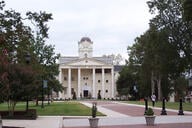You have /5 articles left.
Sign up for a free account or log in.
Americans are donating more money to higher education than they were before the recession, a comprehensive report on charitable giving suggests.
The report, which the Giving USA Foundation released Tuesday, indicates that Americans donated a record $52.07 billion to education in 2013. Adjusted for inflation, this figure marks a 7.4 percent increase over 2012.
The foundation enlisted Indiana University’s Lilly Family School of Philanthropy to write and research its report. Una Osili, the director of research at the Lilly School, estimated that “60 to 70 percent” of dollars donated to education went to higher education. The education category also includes gifts made to K-12 causes, afterschool programs, charter schools and public schools (such as Mark Zuckerberg’s recent $120 million gift to Bay Area public schools, which will factor into next year’s report).
For its analysis of gifts to education, the Giving USA report drew in large part on data from the Council for Aid to Education's Voluntary Support of Education Survey, which measures charitable giving to higher education and private K-12 schools.
Americans in 2013 donated $335.17 billion to charitable causes. Education, which attracted roughly 16 percent of total donations, drew more gifts than any other category except religion. Religious organizations, which raised $105.53 billion in gifts in 2013, have outflanked all other charitable sectors since Giving USA began publishing data in 1956.
Donations to the education sector tapered off during the recession, Giving USA’s data show. In 2007 Americans gave $47.97 billion (in today’s dollars) to education. The next year, $38.84 billion went to education – a decrease of 19 percent. Gifts to education dropped still further in 2009.
Since 2010, however, education-related philanthropy has been on the rise. Osili said gifts to education have “been one of the most rapid increases in the post-recession period.” (In defining the “post-recession period,” the report follows the National Bureau of Economic Research, which holds that the recession ended in June 2009.) Gifts to the arts, environmental organizations and health organizations have also increased in the last three years. The report speculates that during the recession donors viewed these needs as less urgent than hunger relief and poverty alleviation. During the recession years, Americans not only gave less on the whole; they were also more likely to donate to entities such as food pantries and homeless shelters instead of supporting long-term social investments such as education.
John Lippincott, president of the Council for Advancement and Support of Education, said the Giving USA report signals that as far as higher education is concerned, “the economic recession is now well behind us.”
“We’ve returned to normal growth rates – and, in fact, for the education sector, above-normal growth rates – coming out of the recession,” Lippincott said. “It reinforces just how resilient American philanthropy truly is.”
The charitable-giving report, however, illustrates more than just an upward tick in education-related philanthropy.
According to findings from the Council for Aid to Education's Voluntary Support of Education Survey, the fraction of alumni who give to their alma maters “is at a historic low,” Osili said. But the average size of gifts to colleges and universities has increased, the CAE's survey showed. In other words, fewer people are donating larger sums.
In turn, colleges and universities are becoming more reliant on a smaller number of wealthy donors. Institutions that hope to raise $1 billion or more cannot succeed without multimillion-dollar gifts, Lippincott said.
Lippincott said this trend – fewer donors making colossal donations – reflected a growing income gap “between the very wealthy and the middle and lower economic classes.” He added that student debt plays a part in discouraging young alumni from donating to their alma maters.
Osili said that the report noted several gifts of $100 million or more that went to education in 2013.
Some of these gifts attracted national attention when they were reported. Phil Knight, a founder of Nike, paid for a football stadium at the University of Oregon that was projected to cost $68 million. John Arrillaga, a real-estate developer in Silicon Valley, donated $151 million to Stanford University in July for a variety of projects.
Although large gifts by individuals gave national levels of philanthropy a boost, Osili noted that giving by corporations decreased slightly. “That’s an important area for universities to understand,” she said. “Many corporations are increasingly pursuing a more strategic approach to their philanthropy, and this has implications for partnerships between corporations and universities.”
Colleges and universities rank among the most attractive places for donors to direct gifts, Osili said.
“High net worth donors recognize education as an important area where their charitable dollars can make a difference,” the researcher said.
An advantage that colleges and universities have when it comes to fund-raising is their scope, Lippincott said. By giving to a university, donors can invest in medical research, arts and culture, social mobility, economic development or some other cause.
“As a sector there is this breadth of solutions that universities and colleges provide that can appeal to a very broad array of donors,” he said.
This scope, coupled with the fleet of fund-raising professionals that many universities now employ, makes for a potent combination.
There is “no profile” of an institution that tends to attract the most philanthropic dollars, Lippincott said. “It has much more to do with the relationships that the institutions build.”




